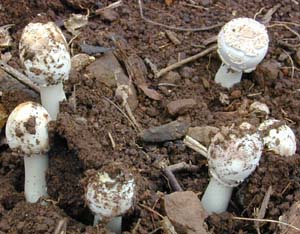|
False Morel
The name false morel is given to several species of mushroom which bear a resemblance to the highly regarded true morels of the genus ''Morchella''. Like ''Morchella'', false morels are members of the Pezizales, but within that group represent several unrelated taxa scattered through the families Morchellaceae, Discinaceae, and Helvellaceae, with the epithet "false morel" most often ascribed to members of the genus ''Gyromitra''. Compared to morels When gathering morels for mushrooms, care must be taken to distinguish them from potentially poisonous lookalikes. A great many morel lookalikes, and even morels themselves are toxic or cause gastrointestinal upset when consumed raw; furthermore, some of them such as ''Gyromitra esculenta'' remain toxic even after conventional cooking methods. Although some false morels can be eaten without ill effect, others can cause severe gastrointestinal upset, loss of muscular coordination (including cardiac muscle), or even death. Incidents o ... [...More Info...] [...Related Items...] OR: [Wikipedia] [Google] [Baidu] |
Gyromitra Esculenta
''Gyromitra esculenta'' is an ascomycete fungus from the genus ''Gyromitra'', widely distributed across Europe and North America. It normally fruits in sandy soils under coniferous trees in spring and early summer. The Ascocarp, fruiting body, or mushroom, is an irregular brain-shaped Pileus (mycology), cap, dark brown in colour, that can reach high and wide, perched on a stout white stipe (mycology), stipe up to high. Although potentially fatal if eaten raw (causing restrictions on its sales in some areas), ''G. esculenta'' is still commonly parboiled for consumption, being a popular delicacy in Europe and the upper Great Lakes region of North America; evidence suggests that thorough cooking does not eliminate all traces of mycotoxins. When consumed, the principal active mycotoxin, gyromitrin, is hydrolyzed into the toxic compound monomethylhydrazine, which hepatotoxicity, affects the liver, neurotoxicity, central nervous system, and sometimes the nephrotoxicity, kid ... [...More Info...] [...Related Items...] OR: [Wikipedia] [Google] [Baidu] |
Mushroom Poisoning
Mushroom poisoning is poisoning resulting from the ingestion of mushrooms that contain toxicity, toxic substances. Signs and symptoms, Symptoms can vary from slight Gastrointestinal tract, gastrointestinal discomfort to death in about 10 days. Mushroom toxins are secondary metabolites produced by the fungus. Mushroom poisoning is usually the result of ingestion of wild mushrooms after misidentification of a Mycotoxin, toxic mushroom as an edible species. The most common reason for this misidentification is a close resemblance in terms of color and general Morphology (biology), morphology of the toxic mushrooms species with edible species. To prevent mushroom poisoning, mushroom gatherers familiarize themselves with the mushrooms they intend to collect, as well as with any similar-looking toxic species. The safety of eating wild mushrooms may depend on methods of preparation for cooking. Some toxins, such as amatoxins, are Thermostability, thermostable and mushrooms containing such ... [...More Info...] [...Related Items...] OR: [Wikipedia] [Google] [Baidu] |
Verpa Conica
''Verpa conica'', commonly known as the bell morel or the early morel, is a species of fungus in the family Morchellaceae. Sometimes mistaken for a true morel, this species is characterized by a pileus (mycology), cap resembling a thimble that is freely attached to the stipe (mycology), stipe. Taxonomy The species was first described under the name ''Phallus conicus'' by Otto Friedrich Müller in 1775. Later authors have moved the taxon to various genera: Persoon placed in ''Leotia'' in 1801, Samuel Frederick Gray transferred it ''Relhanum'' in 1821, while Otto Kuntze moved it to ''Monka'' in 1898. The species was transferred to ''Verpa'' by Olof Swartz in 1814. Description Fruiting bodies have a smooth pileus (mycology), cap that is bell-shaped or conical, and tall and broad; it is attached to the top of the stipe only, the margin of the cap is free – hanging like a skirt. The underside of the cap is tan (color), tan to dark brown in color. The stipe (mycology), stipe, w ... [...More Info...] [...Related Items...] OR: [Wikipedia] [Google] [Baidu] |
Verpa Bohemica
''Verpa bohemica'' is a species of fungus in the family Morchellaceae. The synonym ''Ptychoverpa bohemica'' is often used by European mycologists and it is commonly known as the early morel or the wrinkled thimble-cap. The mushroom has a pale yellow or brown thimble-shaped cap— in diameter by long—that has a surface wrinkled and ribbed with brain-like convolutions. A feature distinguishing the species from true morels (genus ''Morchella''), the cap hangs free from the top of the stem, which is lighter in color, brittle, and up to long by thick. Microscopically, the mushroom is distinguished by its large spores, typically 60–80 by 15–18 μm, and the presence of only two spores per ascus. ''Verpa bohemica'' is found in northern North America, Europe, and Asia. It fruits in early spring, growing on the ground in woods following the snowmelt, before the appearance of true morels. Although widely considered edible, if incorrectly prepared, consumption of the mushroom ... [...More Info...] [...Related Items...] OR: [Wikipedia] [Google] [Baidu] |
Verpa
''Verpa'' is a genus of ascomycete fungi related to the morels. Resembling the latter genus in edibility and form, the common name early morels is popular. There are five species in the widespread genus. Taxonomy Analysis of the ribosomal DNA of many of the Pezizales showed the genus ''Verpa'' to be closely related to the genus ''Morchella'', and also '' Disciotis''. Thus the three genera are now included in the family Morchellaceae. Species Species include: *'' Verpa bohemica'' - early morel. : Edible if well cooked. Found in North America, in early spring, April–May in damp places, under poplar *'' Verpa conica'' - bell or conic morel. : Edible if well cooked. Found in North America, in orchards, in eastern Canada. *''Verpa digitaliformis'' *''Verpa krombholzii'' *''Verpa speciosa'' Etymology ''Verpa'' comes from the Latin word for ''erection An erection (clinically: penile erection or penile tumescence) is a Physiology, physiological phenomenon in which t ... [...More Info...] [...Related Items...] OR: [Wikipedia] [Google] [Baidu] |
Poland
Poland, officially the Republic of Poland, is a country in Central Europe. It extends from the Baltic Sea in the north to the Sudetes and Carpathian Mountains in the south, bordered by Lithuania and Russia to the northeast, Belarus and Ukraine to the east, Slovakia and the Czech Republic to the south, and Germany to the west. The territory has a varied landscape, diverse ecosystems, and a temperate climate. Poland is composed of Voivodeships of Poland, sixteen voivodeships and is the fifth most populous member state of the European Union (EU), with over 38 million people, and the List of European countries by area, fifth largest EU country by area, covering . The capital and List of cities and towns in Poland, largest city is Warsaw; other major cities include Kraków, Wrocław, Łódź, Poznań, and Gdańsk. Prehistory and protohistory of Poland, Prehistoric human activity on Polish soil dates to the Lower Paleolithic, with continuous settlement since the end of the Last Gla ... [...More Info...] [...Related Items...] OR: [Wikipedia] [Google] [Baidu] |
Monomethylhydrazine
Monomethylhydrazine (MMH) is a highly toxic, volatile hydrazine derivative with the chemical formula . It is used as a rocket propellant in bipropellant rocket engines because it is hypergolic with various oxidizers such as nitrogen tetroxide () and nitric acid (). As a propellant, it is described in specification MIL-PRF-27404. MMH is a hydrazine derivative that was once used in the orbital maneuvering system (OMS) and reaction control system (RCS) engines of NASA's Space Shuttle, which used MMH and MON-3 (a mixture of nitrogen tetroxide with approximately 3% nitric oxide). This chemical is toxic and carcinogenic, but it is easily stored in orbit, providing moderate performance for very low fuel tank system weight. MMH and its chemical relative unsymmetrical dimethylhydrazine (UDMH) have a key advantage that they are stable enough to be used in regeneratively cooled rocket engines. The European Space Agency (ESA) has attempted to seek new options in terms of bipropellant rock ... [...More Info...] [...Related Items...] OR: [Wikipedia] [Google] [Baidu] |
Carcinogenic
A carcinogen () is any agent that promotes the development of cancer. Carcinogens can include synthetic chemicals, naturally occurring substances, physical agents such as ionizing and non-ionizing radiation, and Biological agent, biologic agents such as viruses and carcinogenic bacteria, bacteria. Most carcinogens act by creating mutations in DNA that disrupt a cell's normal processes for regulating growth, leading to uncontrolled cellular proliferation. This occurs when the cell's DNA repair processes fail to identify DNA damage allowing the defect to be passed down to daughter cells. The damage accumulates over time. This is typically a multi-step process during which the regulatory mechanisms within the cell are gradually dismantled allowing for unchecked Cell division, cellular division. The specific mechanisms for carcinogenic activity is unique to each agent and cell type. Carcinogens can be broadly categorized, however, as activation-dependent and activation-independent ... [...More Info...] [...Related Items...] OR: [Wikipedia] [Google] [Baidu] |
Gyromitrin
Gyromitrin is a toxin and carcinogen present in several members of the fungal genus '' Gyromitra'', like '' G. esculenta''. Its formula is . It is unstable and is easily hydrolyzed to the toxic compound monomethylhydrazine . Monomethylhydrazine acts on the central nervous system and interferes with the normal use and function of vitamin B6. Poisoning results in nausea, stomach cramps, and diarrhea, while severe poisoning can result in convulsions, jaundice, or even coma or death. Exposure to monomethylhydrazine has been shown to be carcinogenic in small mammals. History Poisonings related to consumption of the false morel ''Gyromitra esculenta'', a highly regarded fungus eaten mainly in Finland and by some in parts of Europe and North America, had been reported for at least a hundred years. Experts speculated the reaction was more of an allergic one specific to the consumer, or a misidentification, rather than innate toxicity of the fungus, due to the wide range in effects s ... [...More Info...] [...Related Items...] OR: [Wikipedia] [Google] [Baidu] |
Gyromitra Colima
''Gyromitra'' () is a genus of about 18 species of ascomycete fungi. They are a false morel - a frequently toxic mushroom that can be mistaken for edible mushrooms of the genus ''Morchella'' (morels). Taxonomy The name ''Gyromitra'' comes from ''gyro'' meaning ''convoluted'' and ''mitra'' meaning ''turban''. Analysis of the ribosomal DNA of many of the Pezizales showed the genus ''Gyromitra'' to be most closely related to the genus ''Discina'', and also '' Pseudorhizina'', '' Hydnotrya'', and only distantly related to ''Helvella''. Thus the four genera are now included in the family Discinaceae. Species The genus consists of the following species: * '' Gyromitra accumbens'' Harmaja (1986) * '' Gyromitra apiculatula'' (McKnight) Berthet (1972) * '' Gyromitra arctica'' Vassilkov (1969) * '' Gyromitra bubakii'' Velen. (1922) * ''Gyromitra californica'' (W. Phillips) Raitv. (1965) * '' Gyromitra chirripoensis'' L.D. Gómez (1972) * '' Gyromitra columbiana'' Harmaja (1986) * '' G ... [...More Info...] [...Related Items...] OR: [Wikipedia] [Google] [Baidu] |
Mushroom
A mushroom or toadstool is the fleshy, spore-bearing Sporocarp (fungi), fruiting body of a fungus, typically produced above ground on soil or another food source. ''Toadstool'' generally refers to a poisonous mushroom. The standard for the name "mushroom" is the cultivated white button mushroom, ''Agaricus bisporus''; hence, the word "mushroom" is most often applied to those fungi (Basidiomycota, Agaricomycetes) that have a stem (Stipe (mycology), stipe), a cap (Pileus (mycology), pileus), and gills (lamellae, sing. Lamella (mycology), lamella) on the underside of the cap. "Mushroom" also describes a variety of other gilled fungi, with or without stems; therefore the term is used to describe the fleshy fruiting bodies of some Ascomycota. The gills produce microscopic Spore#Fungi, spores which help the fungus spread across the ground or its occupant surface. Forms deviating from the standard Morphology (biology), morphology usually have more specific names, such as "bolete", " ... [...More Info...] [...Related Items...] OR: [Wikipedia] [Google] [Baidu] |




